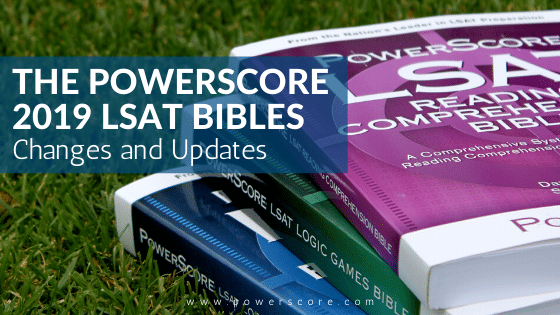Every year I make revisions and updates to the LSAT Bibles, and there are several different reasons for that. First, at least three new LSATs are released each year. I make changes to account for new wrinkles used by the test makers. Second, I talk with many different LSAT students and also teach various sessions throughout the year, and the feedback I receive helps me shape and improve parts of each book. Finally, as I discussed previously, the books have changed so much over time that providing new versions each year helps students know they are getting the most up-to-date information possible.
Because of this, one of the most common questions we receive is: what has changed, and do I need to get the newest editions if I already have an older version? We’ll address those questions in this post!
First, the good news is that all three 2019 LSAT Bibles have been revised and fully updated, and we have made the newest versions available for order on our website.
Next, let’s discuss the changes book by book, starting with the one that changed the most:
The LSAT Reading Comprehension Bible
The 2019 version of the RCB is 12 pages longer than the 2018 version, and 35 pages longer than the 2017 version.
This year saw a continuation of the substantial changes begun in the 2017 and 2018 editions. There are further refinements to the overall flow of the strategic discussions, as well as cover to cover revisions to the text itself. The 2019 RCB represents a significant prose overhaul. The aim is to make the book more linear and easier to read. The end result is a volume that should feel both cleaner and more cohesive than prior editions!
In addition, the 2019 version now includes:
- Analysis of new question types, including Point at Issue and Point of Agreement
- A section on Rephrasing to help students better parse confusingly-worded question stems
- An examination of authors’ explicit and implicit beliefs and how to determine each
- Additional advice on improving reading speed (something we call “comfort versus the clock”)
- A Prephrasing Test to perfect your answer choice prediction skills
- Expanded coverage of key ideas like active reading, common test traps, and becoming a more regular/routine daily reader.
This was undoubtedly the most extensive set of revisions made to the Bible Trilogy this year. We strongly encourage students to prep with the new 2019 RCB if possible.
The LSAT Logic Games Bible
The 2019 version of the LGB is 4 pages longer than the 2018 edition, and 28 pages longer than the 2017 edition.
As opposed to prior years (for example, 2018 and 2016) the changes this year were more minimal. The main focus was on improving the approach to using the book and on helping students to best absorb the ideas in the book. Discussions were also added to optimize the study and practice routine of the ideas. The overall effect should be to allow students to increase scores as much as possible. In addition, numerous small text changes were made to improve accuracy and clarity.
Only the 2018 and 2019 versions should be used. Major changes to the LGB in 2016 fully invalidated all prior versions.


Laura Barron says
Good afternoon.
So, I guess the most up to date are the most beneficial…
Dave Killoran says
Indeed they are, and with that in mind here are the 2020 updates: https://blog.powerscore.com/lsat/the-powerscore-2020-lsat-bibles-what-has-changed/
Fwiw, I update the LSAT Bibles every year and I talk about why I make those changes here: The LSAT Bibles: Do You Need the Newest Editions? For more info on how it works, you can also listen to our podcast discussion on the various versions and why using the most recent one makes a difference: See Episode 14, at the 51:55 mark.
Thanks!